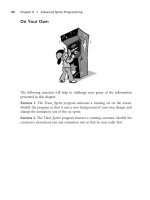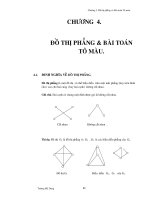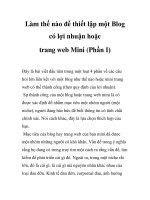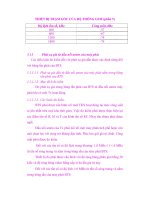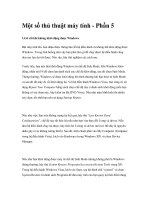Mobile Web Development phần 5 potx
Bạn đang xem bản rút gọn của tài liệu. Xem và tải ngay bản đầy đủ của tài liệu tại đây (790.77 KB, 23 trang )
Chapter 4
[ 81 ]
At the heart of any device detection is the User Agent header sent by the browser. All
device detection techniques check the User Agent ($_SERVER['HTTP_USER_AGENT']
variable for PHP) and look up their database to nd the characteristics of that device.
Here are some of the things WURFL can tell you about a device:
Screen size of the device
Supported image, audio, video, ringtone, wallpaper, and screensaver formats
Whether the device supports Unicode
Is it a wireless device? What markup does it support?
What XHTML MP/WML/cHTML features does it support? Does it work
with tables? Can it work with standard HTML?
Does it have a pointing device? Can it use CSS?
Does it have Flash Lite/J2ME support? What features?
Can images be used as links on this device? Can it display image and text on
the same line?
If this is an iMode phone, what region is it from? Japan? US? Europe?
Does the device auto-expand a select drop down? Does it have inline input
for text elds?
What SMS/MMS features are supported?
The list goes on. But you can make some intelligent decisions in your application
based on the device now. You can even conditionally print <wall> tags. E.g. show a
download link only if the device has download support.
WURFL API is available in many programming languages, including Java, PHP, .Net,
Ruby, and Python. You can download it from: />XML Processing can Bog Down My Server, is There
Something Easier?
Yes! The WURFL XML le is above 4MB, and despite many structural optimizations,
processing it on every request will certainly slow down your server. Many APIs
provide caching to speed things up. But having this available in a database will be best.
Tera-WURFL is a PHP package that uses MySQL to store WURFL data. It bundles
WALL and an admin panel—making it the top choice for mobile web adaptation.
Setting up Tera WURFL involves downloading the latest package from
extracting the les and entering the database
connection information in the conguration le. It will load up the device data to
the database and can start serving WALL pages.
•
•
•
•
•
•
•
•
•
•
•
Adapting to User Devices
[ 82 ]
What About W3C's DIAL?
W3C's DIAL (Device Independent Authoring Language) is a combination of
XHTML 2, XForms, and DISelect. DIAL ( was
created to develop a language that will allow consistent delivery across devices and
contexts. Though the language is new, it's getting a good response and is something
to keep track of!
Other Useful Tools for Adaptation
Adapting a site for different devices goes beyond markup generation. Commercial
tools such as Changing Worlds, Dynetic, and Volantis do a good comprehensive job
in adaptation. Let us look at some more interesting open-source tools in this area.
Dynamically Resizing Images
If we can generate markup code dynamically, we might as well resize images
dynamically! Maybe we can detect the screen size using WURFL and write logic that
will resize a large image to t the device screen. This will increase the load on the
server a little bit as we resize the image, but we can save the image to disk for later
usage and manage the additional load. This will cut down on the chore of resizing
images for different resolutions every time we add one.
There are a few ready libraries that work with WURFL and can resize images and
even change their format.
GAIA Image Transcoder (
is one such tool in Java. It even lets you dene regions of interest to help in preview
and place on the image.
PHP Image Rendering Library ( />phpimagerendering.php) is another implementation in PHP.
Image Server (
can work as a lter for your Java server, optimizing images without a trace of what's
happening to the user!
Quick and Easy Way to Make Your Blog Mobile
If the job at hand is to make a mobile web version of a blog, you can do it in a
matter of minutes! FeedBurner () and Feed2Mobile
( take the RSS feed from your blog and show it
in a mobile-friendly manner. Users just point to the new URL and they can access
your mobile blog!
Chapter 4
[ 83 ]
If you want full control, and want to set up something on your blog itself, head for
Mobile Web Toolkit (). MWT's WordPress plug-in can get
your blog mobile within 10 minutes. MWT allows you to customize what widgets
show up to users of different browsers in a friendly AJAX editor. Plug-ins for other
content management systems are on their way. MWT is a very interesting concept
and advocates delivering a rich experience to mobile users, rather than restricting
them with some lowest common denominator design.
On the other hand, many content management systems have now started supporting
versions adapted to mobile devices. By the time this book goes to print, all major
CMS will have mobile web support.
MyMobileWeb: Going the Semantic Way
MyMobileWeb ( is a Java-based open-source
tool to build .mobi-compliant websites. It is a comprehensive framework that uses
declarative XML to build the presentation layer (very similar to WALL) and an MVC
architecture for handling various events.
MyMobileWeb is an ambitious project. The team is working on semantic mobile web,
context awareness and mobile AJAX. Some of the features that may interest you:
It does not do markup transcoding at run time, but generates device-specic
pages at publish time. This gives better performance.
The visual controls are dened through a declarative language and can
interoperate with JSTL for dynamism. They are also rendered based on the
context or rules that we can specify.
The framework comes with ready visual controls for layouts, date control,
RSS etc. It can even do binding of visual controls with data, and can generate
a grid to display data and paginate.
You get control over the visual aspects—CSS, alternatine content, hiding
pages based on device, etc.
It has a validation framework that can work on both client side and server
side depending on scripting support at the client.
Comes with an Eclipse plug-in!
•
•
•
•
•
•
Adapting to User Devices
[ 84 ]
HAWHAW: As Simple as a Laugh?
HAWHAW ( has a funny acronym, but is a great idea.
It stands for HTML And WML Hybrid Adapted Webserver. HAWHAW is an
open-source script written in PHP. You can create HAWHAW pages via PHP or
XML. But the interesting thing about it is that it can even generate VoiceXML output.
So not only can you build your standard and mobile website with it, you can even
have people call in a number and do a complete interactive voice response system.
You can even get some ideas from the HAWHAW implementation and build
something of your own.
Summary
In this quick chapter, we learned when to adapt and how to adapt our mobile site to
different devices. Specically:
We learned about the Lowest Common Denominator method, nding and
comparing features of different mobile devices and deciding to adapt or not.
We extended the Pizza On The Run application to adaptively display content
using Wireless Abstraction Library.
We saw how adaptation works in different browsers.
We learned about WURFL and how it can be used to adapt based on
browser capabilities.
We reviewed tools that can aid in adaptation—Tera WURFL, MyMobileWeb,
Mobile Web Toolkit, Image Server, GAIA Image Transcoder, and
HAWHAW.
One note of caution! Do not over-constrain the content. Users expect the same kind
of experience on the mobile that they have on the Web. As mobile web developers,
we must strive to bridge the gap, not widen it.
In the next chapter, we will review the best practices of mobile web development: the
standards and the opinions!
•
•
•
•
•
Developing Standards-
Compliant Sites
The variety of device capabilities is one of the biggest constraints in mobile web
development. In this chapter, we will learn about developing standards-compliant
sites and in the process learn essential tricks in delivering the best experience to
the users.
We will specically look at:
Running the ready.mobi test on your site
Creating the structure, design, markup, and navigation for best user experience
Collecting user behavior data to keep enhancing the site
After the adaptation work we did in the last chapter, Luigi is ready to roll out the
Pizza On The Run mobile site to a wider audience. He's got ideas for making POTR
more interactive (Web 2.0 style) and utilizing phone capabilities. But before we can
do all that, we need to ensure that our site follows the best practices of mobile
web development.
So let's go ahead and get POTR to the pit!
Running the ready.mobi Test
We could learn all the standards and best practices before we start development.
But what's the fun in success if there were no failures behind it? So, how can we nd
out how badly (or well) we are doing in terms of mobile web best practices? Simple!
Run the ready.mobi test on it! Ready.mobi is an online service that can review
your mobile website and give feedback on a variety of aspects—XHTML, images,
download sizes, etc. Let's see how our current site does on the ready.mobi test!
•
•
•
Developing Standards-Compliant Sites
[ 86 ]
Time for Action: Test Your Site's Mobile Readiness
with the ready.mobi Test
1. Upload your site to a server, so that it can be accessed using a public URL.
2. Access it from your browser/emulator to ensure the site loads and works
without any errors.
3. Open i/ in your browser. Enter your site address in the
form and submit.
4. On the next page, you will see the ready.mobi report as shown in the
following screenshot.
Chapter 5
[ 87 ]
5. Check the overall readiness score as well as the speed test results. You can
also review how your page will look on devices in the Visualization section.
Take a look at the next screenshot, that demonstrates this.
6. Check if you have any fails—indicated by red marks. If you have no red
signs, go ahead, make your site live. Don't forget to tell all your friends about
your latest venture! On the other hand, if you do have fails, you may want to
x them before going live!
Developing Standards-Compliant Sites
[ 88 ]
7. We have two fails, resulting from the "name" attribute on <a> in our code,
because the name attribute is not supported by the XHTML MP DTD we are
using. The following screenshot shows the note about compliance test failure.
This is a common mistake that we talked about in an earlier chapter. The
solution is to use "id" attribute instead of "name" for identifying
the anchors.
So What is Happening?
This is a comprehensive test that validates the page at the URL you entered. It
validates against the XHTML MP standard, and .mobi's best practices of mobile web
development. ready.mobi is an excellent tool to check how much time your page will
take to load, whether it will render well across different browsers, and even whether
it is semantically well constructed for mobile users.
You can validate only one page with ready.mobi. So you will have to
enter page addresses one by one to test your whole site.
Chapter 5
[ 89 ]
Click inside one of the emulators to give focus to them. Now, navigate
your site using just the keyboard. This will give you a good idea of how
most mobile users will be accessing your site.
The following screenshot shows a list of tests ready.mobi runs apart from the
standards-compliance tests. In the report, clicking on any item will open up notes
about that test. This is a great way to explore and learn the best practices of mobile
web development.
Now that we know how to run this test, let us review recommendations and best
practices of mobile web development.
Creating the Structure, Design, Markup,
and Navigation for Best User Experience
Learning XHTML and developing mobile sites is not that difcult. The real problems
come when you want to ensure that the site works well across different devices.
Adaptation certainly helps in the process, but if you know the pitfalls, your ride can
be smoother.
Developing Standards-Compliant Sites
[ 90 ]
There are a few notable efforts in the mobile web space that come up with best
practices and recommendations.
W3C Mobile Web Best Practices Basic Guidelines ( />mobile-bp/)
Luca Passani's Global Authoring Practices ( />OpenWave's Guidelines about XHTML Design (http://developer.
openwave.com/dvl/support/documentation/guides_and_references/
best_practices_in_xhtml_design/index.htm)
Opera's Making Small Devices Look Great (See />community/dev/device/)
You should go through the best practices above for a deeper understanding of
the rationale behind each recommendation. For this chapter, we have developed
checklists you can use on your projects. These checklists come from the
recommendations above as well as our experience in developing mobile and
web applications.
Mobile Web Development Checklists
You can create your own version of these checklists, print them, and review them
on your mobile web projects. Just keep checking off what's done, and understand
what more can be done. The checklists are grouped by sections for easy reference.
Strategy
Why mobile?
Target users identied
User goals dened, and task oriented
Short URL for the homepage. No www. Maybe new subdomain
User browser detection and delivering appropriate content
Consistent delivery across devices
Can something still be taken out of the page? Stay lean!
Testing Setup
Testing in web browser
Testing with 5 device emulators
Testing with 2 real devices
Testing with real users
•
•
•
•
•
•
•
•
•
•
•
•
•
•
•
Chapter 5
[ 91 ]
Structure and Page Information
Uses correct encoding—UTF-8 by default
Sends correct XHTML doctype
No frames, no pop-ups
Page redirects on the server side, unless application needs it
Short yet descriptive title for all pages
Is the page structure understandable? Flows naturally?
Minimum external resources (CSS, images, etc.)
Design and CSS
Target resolution?
Is high color contrast maintained?
Usable with background images off?
No tables, unless device support is guaranteed
No nested tables, no tables for layout
Textual representation of all non text elements (images, media, etc.)
No pixel-based designs, use relative measures like em
CSS for design
No extraneous CSS code
Font agnostic design
Works with CSS off
Uses lists for structure—ol, ul, dl
Small icons are good, used where needed
Consistent color theme across the site
No wasted vertical space
Uses blocks for page elements
Background color to distinguish different blocks
Unimportant text in gray color
•
•
•
•
•
•
•
•
•
•
•
•
•
•
•
•
•
•
•
•
•
•
•
•
•
Developing Standards-Compliant Sites
[ 92 ]
Images
No images without alt tag
Tested with images turned off
Image size according to device size
Image size specied in XHTML
Image resizing on the server, not at client
No spacer images
No image maps
Navigation and Links
Shortest click-stream possible for each task
No navigation bar in the header
Check: is breadcrumb navigation adding value? Really?
Most important links at the top
Home, Contact, and few more important links in footer
accesskey for important links in the page
No more than 10 links on a page
Clear, action-oriented label on each link
Hide links to unsupported document types
Site search in footer if needed
Google sitemap present
Links are search-engine friendly—avoid GET parameters via ? and &
Content
Maximum 5 scrolls long
No splash pages
No stub pages without actual content or with links only
Important content at top
Clear and concise language for content
Error messages, in the same language as content
No unrelated content—check: will the user want it?
Scrolls in one direction only, unless application needs secondary scroll
•
•
•
•
•
•
•
•
•
•
•
•
•
•
•
•
•
•
•
•
•
•
•
•
•
•
•
Chapter 5
[ 93 ]
Markup
Is the markup valid?
No redundant markup; must be tidy
Total page size (including markup, images, CSS) less than 20K
XHTML is semantic, e.g. no h2 before h1
Uses XHTML code for formatting, aided by CSS
Minimal form elements, especially select boxes
User Input
Avoids free text entry where possible
Default selections/values as much as possible
Default input mode, format, and language for elds
Password eld as input type="text", not input type="password", unless high
security is needed
Objects, Security, Caching, Etc.
No scripting without device detection + alternative
No embedded objects without device detection + alternative
Works without cookies
Cache-Control header as per application need
Pass session ID in URL
Not mandatory to log in to see content, unless application requires so
Phone numbers are linked to invoke call
Best Practices should be Upgraded!
When you develop your applications, you may keep the target devices and target
users above the best practice recommendations. Best Practices are opinions and you
will see arguments for and against some of the controversial items. You can come up
with your own rules thumb of and tricks. Start with the items here, try them out on
your projects, and keep evolving them.
•
•
•
•
•
•
•
•
•
•
•
•
•
•
•
•
•
Developing Standards-Compliant Sites
[ 94 ]
Most Good Styles of Design and Software will
Work on the Mobile Web Too
The mobile web is just another platform of delivering information. All good usability
practices, graphic design patterns, and software development practices you have
learned so far are still applicable to the mobile web. They are actually a base that you
build your mobile development patterns on.
What's most important for any application is that it serves user needs. We may
develop a mobile website, but the users may nd it very difcult to use it. We can
wait for them to send us complaints or be proactive and try to nd out if they are
having problems.
Luigi is very sensitive about his customers, so he wants to nd out if they are having
any troubles. So after applying all the best practices, we still want to put in place
a routine to track user behavior and provide an opportunity to them to give us
feedback. Let us see how we can do this.
Collecting User Behavior Data
We could follow all the best practices of mobile development. But what if we become
proactive and try to understand how the user uses our application? If we track
the pages our users are visiting, and how much time they are spending on each,
we can get a fair sense of how the application is working for them. If we also track
the browser data and some other application parameters, we will get a reasonably
good picture of what's working and what's not working. If we nd out that most
of our users do not go past the rst page in the ordering process, we know there is
something wrong. We need to simplify the workow.
Collecting user behavior data can allow us to generate intelligence out of the data. It
will help us evolve our best practices and increase user satisfaction. Now we can use
the web server logs for tracking page views. But we get full exibility with our own
tracking system. How can we set up a simple tracking system for POTR? The job is
very easy for us because we have a centralized architecture. Let's see how we can do it.
Time for Action: Implementing User Tracking
1. Create a new table in the database. The following code shows the schema.
You may use phpMyAdmin or any other database administration tool to
do this.
CREATE TABLE `trackingdata` (
`id` int(10) unsigned NOT NULL auto_increment,
`userId` int(10) unsigned NOT NULL,
Chapter 5
[ 95 ]
`sessionId` varchar(40) NOT NULL,
`accessTime` timestamp NOT NULL default CURRENT_TIMESTAMP,
`action` varchar(20) NOT NULL,
`page` varchar(255) NOT NULL,
`referer` varchar(255) NOT NULL,
`browser` varchar(200) NOT NULL,
`timeSpent` int(6) unsigned NOT NULL,
`vars` text NOT NULL,
PRIMARY KEY (`id`)
) ;
2. Open up prepend.inc.php. We will write a function to collect tracking
information and insert it into the trackingData table.
3. Add the following logUserTrail() function in prepend.inc.php—add it
after the debug() function denition. In the function, we insert the current
request URI, all the variables associated with it, the last page, etc. into the
table. We also save the ID of the tracking data item into the session. In the
next call to this function, when we nd the tdId, we update that record
with the time spent on that page—which will be the current time minus
accessTime for that request.
function logUserTrail()
{
$userId = isset($_SESSION['userId']) ? $_SESSION['userId'] : 0;
$page = "http://".getenv('HTTP_HOST').getenv('REQUEST_URI');
// If trackingId of last request is set, update its timeSpent
if (isset($_SESSION['tdId']))
{
$query = "UPDATE trackingData SET timeSpent =
NOW() - accessTime WHERE id = '".$_SESSION['tdId']."'";
$GLOBALS['db']->Query($query);
}
// Insert current request information in trackingData
$query = "INSERT INTO trackingData (userId, sessionId, action,
page, referer, browser, vars)
VALUES ($userId, '".$_REQUEST["PHPSESSID"]."', '".$_
REQUEST['action']."', '$page',
'".getenv('HTTP_REFERER')."', '".getenv(
'HTTP_USER_AGENT')."', '".serialize($_REQUEST)."')";
$GLOBALS['db']->Query($query);
$_SESSION['tdId'] = $GLOBALS['db']->GetCurrentId();
}
Developing Standards-Compliant Sites
[ 96 ]
4. Now open index.php and call the function we just wrote. We should do it
before including the action le.
$action = isset($_REQUEST["action"]) ? $_REQUEST["action"] : "home";
$file = $action . ".inc.php";
logUserTrail();
if (in_array($action, $validActions) && is_file($file) )
{
include($file);
}
5. Now access the POTR site. Browse around on a few pages. Conrm that the
data is inserting into the table through your favorite administration tool.
6. Our tracking mechanism is now in place. After a few requests, doing a
query like SELECT userId, action, timeSpent, browser, vars from
trackingData may give an output similar to what is shown in the next
screenshot. Notice the vars eld gives us values that tell us the exact action
the user was trying to perform. In the highlighted case, a non logged in user
was on the rst step of the order process, and spent 4 seconds on it.
Chapter 5
[ 97 ]
How is All the Data Tracked?
The logUserTrail() function gets called on every request to our site. In the function,
we can get the current page and last page links using the HTTP_REQUEST_URI and
HTTP_REFERER server-side variables. We are storing the session and user IDs so that
we can run queries on them later. The serialize() function takes all the variables
in the current request and converts them into a string. This will allow us to track the
actual step in the order process or the address the user was entering.
We can now query the collected data and get insights into how customers are using
our application. Some interesting queries could be:
Find all exit pages: SELECT * FROM trackingData WHERE timeSpent = 0
Find pages slow to process for the user: SELECT * FROM trackingData WHERE
timeSpent > 20.
Find popular modules: SELECT action, count(*) as total FROM
trackingData GROUP BY action ORDER BY total DESC.
Covering Problem Areas
We are just tracking successful requests in the current process. If we add an HTTP
error handler page, we can also track causes of HTTP errors like 404, 500 or others.
We can also add an exception/error handler in PHP, which can track the source of
problems in PHP code as well. This data can be linked to the session/user ID and we
can have a complete picture of what was happening when the error occurred.
Tapping into the Device Data
We are tracking the user's browser. We can link it up with the WURFL data we have
and generate insights into which devices are used most, what are their capabilities,
and how can we exploit them.
Making it Easier to Ask for Help
Despite all this, if the user faces a problem, we want to make it easier to ask for
support. This can be done simply by creating a feedback page, and linking it up from
the footer navigation. The form will allow the user to add comments, will include the
tracking data ID, and send us an email with full details.
We are not including code for this here! You can build it on your own, or check it out
in the source code you may download from the book website.
•
•
•
Developing Standards-Compliant Sites
[ 98 ]
Luigi, our dear client, is very excited with all this. We mentioned that he wants to
add many interactive features to POTR now. But before that, let's see what we did in
this chapter.
Summary
In this chapter, we focussed on what we should do to ensure that our mobile site is
delivered well to most customers. Specically:
We tested POTR with ready.mobi. We saw the different tests it carries out
and notes it shows. It's not necessary to x all problems, but it helps!
We also saw the different recommendations and best practices about mobile
web development. We referenced W3C's Mobile Web Best Practices, Luca
Passani's Global Authoring Practices, and built a checklist we can use on our
projects.
Following recommendations may not be enough. We started tracking user
data on POTR through our central index.php le.
In the next chapter, we will look at how we can push updates to customers via SMS.
Luigi has been pushing for this feature for quite some time, and we are now ready to
take it up!
•
•
•
Sending Text Messages
SMS-based applications have taken the mobile world by a storm. According to
research, there are two types of mobile users: texters and talkers. It was observed
that the texters send more than double the messages that talkers do. SMS for them is
a non-obtrusive way of communication.
In this chapter, we will learn about sending text messages, and in the process learn
the fundamentals of using third-party services for messaging.
We will specically take look at:
Updating order status for POTR
Selecting an SMS gateway provider and setting up an account
Sending text messages using the gateway's API
Understanding how SMS is delivered
Getting delivery status updates
Setting up our own SMS gateway
Sending bulk messages
We have almost completed the XHTML MP part of POTR and Luigi wants to
build more interaction into the system now. He wants to send order updates to the
customers via SMS. After we did a bit of research, we found that the job is easier than
we think. Let's take a look.
Updating Order Status
Once Luigi's got the order, he will prepare the pizzas and dispatch them. He wants
to update the order status in the system, so that his task of tracking orders becomes
easier. He also wants to send out an SMS notication to the customers telling them
that their order will reach them within half an hour. Before we can send out the
SMS, we need to build an order update process. Let's see how the task becomes
straightforward with our existing framework.
•
•
•
•
•
•
•
Sending Text Messages
[ 100 ]
Time for Action: Updating Order Status
1. We kept a provision for different order statuses when we designed the orders
table. The status eld is an enumerated eld, and can contain one of the
three values: N for New order, P for orders in Process, and C for Completed
orders. Let's add a function to our Order class to update this eld. The
following code shows the function:
public function UpdateStatus($status)
{
$query = "UPDATE ".$this->table." SET status = '$status'
WHERE id = '".$this->_id."'";
if ($GLOBALS["db"]->UpdateQuery($query))
{
$this->status = $status;
return true;
}
return false;
}
2. Next, let's list new orders. For this, we query the orders table for all orders
with status "N". With each item in the list, we will add a checkbox so that
we can mark them as dispatched. Let us make a new le processOrders.
inc.php for this. We also need to add the action "processOrders" to the
$validActions array in index.php. The following code shows the code to
generate this list:
<?php
// File to process orders and mark them as dispatched
$prodObj = new Product();
$products = $prodObj->GetAll("categoryId = 1", "priority asc");
$varObj = new Variation();
$varObj = $varObj->GetAll("", "type asc");
$ordObj = new Order($prodObj, $varObj);
// Load all new orders
$pendingOrders = $ordObj->GetAll("status = 'N'", "orderDate asc");
echo '<h2>Process New Orders</h2>';
if (count($pendingOrders) > 0)
{
echo '<form action="index.php" method="POST">
<fieldset>
<input type="hidden" name="action" value=
"processOrders" /><ul>';
foreach($pendingOrders as $order)
{
$date = date("m/d/y h:i", strtotime($order['orderDate']));
Chapter 6
[ 101 ]
echo '<li><input type="checkbox" name="orderIds[]"
checked="checked" value="'.$order['id'].'"/>
<b>'.$order['id'].' ('.$date.') $'.$order['total'].'</b> <br
/>'.$order['address1'].' '.$order['address2'].',
'.$order['city'].' <i>'.$order['phone'].'</i></li>';
}
echo '</ul><input type="submit" class="button"
name="option" value="Update Orders" />
</fieldset></form>';
}
else
{
echo '<p>No pending orders to process. <a href="?action=
processOrders">Check again.</a></p>';
}
?>
3. When we run the code, it will show up as in the following screenshot.
4. Once the form is submitted, we will get the selected orders' IDs in the
$orderIds array. We can loop over this, and call the UpdateStatus method to
change the status in the table. We add the following code right after creating
$orderObj in processOrders.inc.php.
// If we got order IDs to process, do that
if ($_REQUEST['orderIds'])
{
echo "<h2>Processing </h2>";
$updated = 0;
foreach($_REQUEST['orderIds'] as $orderId)
{
$ordObj->Load($orderId);
// Change the status to 'Processing '
if ($ordObj->UpdateStatus('P'))
{
$updated++;
}
}
echo "<p>$updated orders updated.</p>";
}
Sending Text Messages
[ 102 ]
5. When processed, the page will update the selected orders, and show any new
orders. Luigi can keep refreshing the page and dispatching the orders.
If there are no orders to process, the page will show "No pending orders".
Now that we have order status updates taken care of, let's get to the core of the
Luigi's requirement—sending order dispatch notication to customers via SMS.
Sending SMS Notifications
There are two approaches to sending SMS from a server. You can either connect a
phone/modem to the server and set up your own system or use a third party SMS
gateway service.
We will look at sending messages from your own server later in the chapter. For
now, we will focus on SMS gateways. SMS gateways provide an API or web service
that you can call to send messages.
Getting Started with a Gateway
We will use Clickatell (www.clickatell.com) as our SMS gateway service provider.
Clickatell can send messages to almost all mobile networks in the world at competitive
rates. It also offers a variety of methods to use its API. HTTP is the most common, in
which you send GET or POST requests to its API to send messages.
Time for Action: Registering on Clickatell
1. Go to www.clickatell.com, and register for an account with it.
2. In the registration process, Clickatell will send you the conrmation codes
via email and SMS. Enter them in to conrm your registration.
3. Now go to www.clickatell.com again and login to Clickatell Central using
your login details.
4. Because Clickatell offers multiple connection types, you need to create a
link rst. Go to My Connections from the menu and select to add an HTTP
connection. The following screenshot shows the kind of form you will see.
Chapter 6
[ 103 ]
5. At the minimum, you need to enter a name for this connection. You can also
enter the IP range that can invoke this connection, the default country to send
messages to (so that a zero at the start of the phone number will be replaced
with that country code), and also a URL where status updates can be sent.
6. After submitting the form, you have the new connection set up. Each
connection has an API ID that you need to pass to the gateway while
establishing a connection. The API ID is the most important piece of
information in a connection. The next screenshot shows summary info about
our newly created POTR connection. We are now ready to use Clickatell!
Connection Types
Different gateways offer different connection types. They may offer any of the
following methods:
HTTP/HTTPS: Sending data through GET or POST submission to a URL.
SMTP: Sending a message using email, either from a desktop client or
a server.
FTP: Typically, for bulk messaging. Upload a text le to an FTP server with
request parameters.
XML: Send XML data over HTTP to the API. This makes it easier to send
messages in a batch.
SMPP: Binary socket connection with the gateway. Typically, used for
higher-end applications.
COM Object: Not very common, but allows connection using a COM object
from Windows applications.
Integrating with Clickatell
We are selecting the HTTP method to integrate with Clickatell. HTTP is familiar to
web developers, easy to use, and offers many features. You can pass parameters
to the API as variables in a GET or POST request. Apart from that, HTTP is also
supported by most gateways. A request to send an SMS looks like the following
on Clickatell:
/>=xxxx&to=xxxx&text=xxxx
•
•
•
•
•
•



